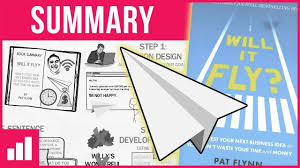Will It Fly? How to Test Your Next Business Idea So You Don't Waste Your Time and Money
Abstract:
Bringing a new business idea to market requires careful planning and execution. Many promising ventures fail due to insufficient market validation. This white paper provides a comprehensive framework for rigorously testing business ideas before investing significant time and resources. We will explore various testing methodologies, discuss their advantages and limitations, and provide practical examples and resources to guide entrepreneurs in their journey.
1. Introduction
The allure of entrepreneurship is undeniable, but the path to success is fraught with challenges. One of the most critical steps is validating a business idea – ensuring there's a genuine market demand for your product or service. This white paper aims to equip aspiring entrepreneurs with the knowledge and tools to effectively test their business ideas and minimize the risk of failure.
2. The Importance of Idea Validation
- Minimizing Risk: Thorough idea validation helps identify potential pitfalls and challenges early on, allowing entrepreneurs to pivot or abandon an idea before investing heavily in it.
- Identifying Target Audience: Validating an idea helps define the ideal customer profile and understand their needs, preferences, and pain points.
- Building a Strong Foundation: A validated idea provides a solid foundation for developing a compelling business plan, attracting investors, and building a successful company.
3. Idea Validation Methodologies
- Market Research:
- Desk Research: Analyzing existing market data, industry reports, competitor analysis, and market trends.
- Resources: Statista, IBISWorld, Google Trends, industry publications
- Primary Research: Gathering firsthand data through surveys, interviews, focus groups, and customer feedback.
- Tools: SurveyMonkey, Typeform, Google Forms
- Desk Research: Analyzing existing market data, industry reports, competitor analysis, and market trends.
- Customer Development:
- Lean Startup Methodology: A framework emphasizing rapid experimentation, iterative development, and customer feedback.
- Key Principles: Build-Measure-Learn, Minimum Viable Product (MVP)
- Customer Interviews: Conducting in-depth interviews with potential customers to understand their needs, motivations, and frustrations.
- Lean Startup Methodology: A framework emphasizing rapid experimentation, iterative development, and customer feedback.
- Competitive Analysis:
- Identifying Competitors: Analyzing direct and indirect competitors, their strengths, weaknesses, pricing strategies, and customer base.
- Competitive Differentiation: Identifying unique selling propositions (USPs) and how to differentiate your offering from competitors.
- Concierge Model:
- Providing Services Manually: Offering your product or service manually before scaling. This allows for direct customer interaction and valuable feedback.
- Example: A food delivery service starting by personally delivering meals to a small group of customers.
- Landing Page Tests:
- Creating a Simple Landing Page: Creating a basic website to gauge interest and capture leads.
- Analyzing Traffic and Conversions: Tracking website traffic, conversion rates, and customer inquiries.
- Pre-orders and Crowdfunding:
- Gauging Demand: Accepting pre-orders or launching a crowdfunding campaign to test demand and generate initial funding.
- Platforms: Kickstarter, Indiegogo, Pre-order platforms
4. Use Cases
- SaaS Startup: Testing a new project management tool by:
- Conducting customer interviews with potential users to understand their workflow challenges.
- Building a basic MVP and offering it to a limited number of early adopters.
- Analyzing user feedback and iterating on the product based on their input.
- E-commerce Business: Testing a new line of handmade jewelry by:
- Creating a simple landing page to showcase the jewelry and collect email addresses.
- Running targeted social media ads to drive traffic to the landing page.
- Analyzing website traffic and conversion rates to gauge interest.
- Food Truck Business: Testing a new food concept by:
- Setting up a pop-up stand at local events and festivals.
- Offering a limited menu and gathering customer feedback on taste, price, and overall experience.
- Adjusting the menu based on customer preferences and demand.
5. Tools and Resources
- Books:
- "The Lean Startup" by Eric Ries
- "Running Lean" by Ash Maurya
- "Validated Learning" by David J. Bland
- Will It Fly? How to Know if Your New Business Idea Has Wings
- Websites:
- StartupBlink
- Entrepreneur.com
- Small Business Administration (SBA)
- Research Papers:
- Academic journals on entrepreneurship, innovation, and marketing.
6. Conclusion
Rigorous idea validation is crucial for the success of any new business venture. By employing the methodologies and strategies outlined in this white paper, entrepreneurs can minimize risk, identify potential pitfalls, and increase their chances of building a thriving and sustainable business. Continuous learning, adaptation, and a customer-centric approach are essential throughout the entire entrepreneurial journey.
Note:
This is a comprehensive outline. You can expand each section with more detailed information, code examples, and real-world case studies. You can also include visuals like diagrams and screenshots to enhance the readability and understanding of the content.
I hope this framework provides a solid foundation for your expanded white paper on testing business ideas.



